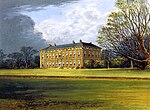Nun Monkton
Civil parishes in North YorkshireUse British English from January 2014Villages in North Yorkshire

Nun Monkton is a village and civil parish in the Harrogate district of North Yorkshire, England. It is situated 8 miles (13 km) northwest of York at the confluence of the rivers Ouse and Nidd. Cottages and houses are grouped around a village green of 20 acres (81,000 m2) with a duck pond and a maypole. The Ouse is navigable for another 19 miles (30 km) and river traffic played an important part in the village's life until the middle of the twentieth century. Until 1974 Nun Monkton was in the West Riding of Yorkshire.
Excerpt from the Wikipedia article Nun Monkton (License: CC BY-SA 3.0, Authors, Images).Nun Monkton
The Avenue,
Geographical coordinates (GPS) Address Nearby Places Show on map
Geographical coordinates (GPS)
| Latitude | Longitude |
|---|---|
| N 54.01444 ° | E -1.22334 ° |
Address
The Avenue
The Avenue
YO26 8ES
England, United Kingdom
Open on Google Maps










